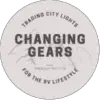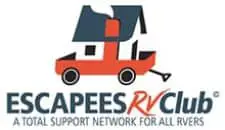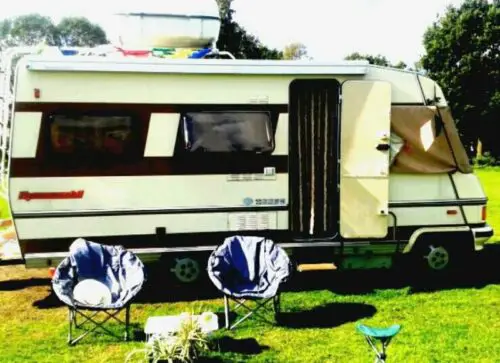Whether you’ve been toying with the idea for a while or had a sudden epiphany, RVing has now become your passion. You’re going to hit the road and live out your Jack Kerouac fantasies. Good for you!
But buying an RV can be an intimidating experience.
So many floorplans, so many brands, so many models …
And that salesman keeps yammering on and on about the electric fireplace … is that really what you need?
Should you buy new or used? How do you inspect and rate the condition of an RV? What the hell is a converter, anyway?!!!
No one is born with the knowledge to successfully navigate the labyrinth that is RV ownership. So don’t feel bad. We’re here to help!
In this RVing 101 Guide to Buying Your First RV, you’ll find everything you need to know before you head to the dealership (including if you should buy from a dealership at all.)
1. Identify Your RV Lifestyle
Have you been living in an RV vicariously via social media? If so, join the club! Thousands of people enjoy following the adventures of nomads and “rubber tramps.”
But the question here isn’t whether you know a lot about traveling in an RV; it’s whether you know anything about RV maintenance, RV costs, RV packing, reversing your rig, climbing mountain passes, etc.
Why Do I Want An RV?
People want RVs for all sorts of reasons.
- Some want to get away for the weekend.
- Others want to get away for the winter.
- Others want a romantic, nomadic life of adventure.
- Others want to retreat into Tolstoy-ian isolation, seeking pure truth to the exclusion of all else, renouncing the hyper-consumerist matrix masquerading as mainstream society. Or something like that.
Whatever your reason, name it. We list the major styles of RVing in our RV Lifestyles Examined post.
How Often Do I Plan To Use My RV?
Realistically evaluating your usage will help you prioritize your needs versus wants during the buying process and can make a huge difference between traveling comfortably and just traveling.
- Full-timers should look to brands offering 4-season insulation packages, extra cargo capacity, big water tanks, and extra batteries.
Who Will Be Coming Along On My RV Adventures?
Are you solo, or do you have a partner? Do you have a family? What about pets? You need to know not only the number but also the habits of each individual who will be sharing your space. Too much space will raise costs, too little space will raise hackles.
- Count the primary passengers
- Count the number of pets
- Count the number of potential guests
Where Will I Go Adventuring?
RVs can go to a lot of places, but not all RVs can go to every place.
Whether you’re planning on hitting luxury campgrounds or scenic back roads, you need to know how your RV can handle the trip. Don’t just jump for the biggest, because it’s not always the best, and tucking into the teeny-tiny may not be necessary.
If you are planning glorious overland expeditions, then consider the following:
- Approach, departure, and ground clearance angles
- Suspension equalization (avoid tandem torsion axles!)
- Maximum length, height, and width restrictions
- 4-season and Arctic insulation packages
MILESTONE: At this point, you’re just a sponge! You’re learning everything you can about the RV lifestyle. Don’t worry coloring between the lines; let your imagination soar! Browse RV forums and read RV blogs.
2. Rent or Borrow First!
Renting an RV, much like renting a house, is a great way to get a feel for what RVing is like, what RVs need, how much they cost to operate, and so on.
Renting also gives you the option of trying out different makes and models before you decide what to buy.
You should spend at least 100 hours in an RV before committing to purchase one for yourself! You need to run through setting up camp, sleeping overnight, unpacking your gear, and figuring out why the fridge isn’t freakin’ cold yet!
See More: The Definitive Guide to Renting an RV
MILESTONE: Now, you have some RVing experience. You’ve shifted into reverse. You’ve lit the stove. You’ve converted the dinette. You’ve been given the middle finger by other drivers speeding by at 85 mph. You can answer newbie questions in a forum. You’re a real RVer, now!
3. Try Out Different RV Floorplans
The floor plan can make or break your RV experience.
The best thing to do is visit RV shows and walk through as many RVs as you can! Imagine yourself in the space. If you like a floorplan, spend at least 10-15 minutes carefully walking through it, imagining yourself performing routine tasks.
Sleeping
- Lay on the bed! Roll around. Stretch. Does your head bump anything? Is there room to sit up? Are there reading lights close by?
- Do you want to make and stow your bed every morning, or do you need a fixed, permanent sleeping space?
- Can the kids access their bunk beds?
- Do you and your partner prefer a single bed or double twin beds?
Kitchen & Dining
- Is the oven large enough to cook a pasta/pizza/turkey?
- Do you prefer a separate breakfast nook?
- Will the whole family fit at the kitchen dinette?
- Is there a pantry? Spice rack? Built-in cutting board?
- Is the fridge and freezer big enough for your grocery needs?
- Where will you store the pots, pans, and large kitchenware?
- How deep is the sink? 8” is the minimum preferred! Double- or single bowl?
- How many stove burners? Are they big enough to accommodate 10” pans?
- Can you access the fridge with the slide-outs closed?
Living & Lounge
- Can you access the interior spaces with the slide-outs closed?
- If you’re a TV family, does everyone have an acceptable vantage point?
- If you’re a board game family, will the table fit the expanded version of Settlers of Catan: Cities and Knights?
- Are there sufficient windows for natural lighting, or do you feel claustrophobic?
Bathroom
- Walk into the shower and close the door. Is it big enough? Do you fit underneath the shower head? Is there a skylight?
- Sit on the toilet (it’s awkward, but do it). Do you fit comfortably? RVs don’t follow ADA guidelines! There’s no one-size-fits-all rule!
- Are you willing to accept a wet bath, or do you require a separate dry bath?
- How much cleaning and laundry storage do you need in a bathroom?
- Does the master bedroom have a dedicated or shared bathroom?
Cargo
- Open all closets. Are they wide enough and deep enough? Bring a measuring tape – many RV closets are not full depth! (24 inches)
- Look into the exterior cargo compartments. Are they pass-through compartments, accessible from both sides?
- Is there a receiver hitch on the rear of the trailer frame? Weight rating?
- If the RV has a bumper, is it large enough (4×4) for a sewer hose?
- Does the RV have a roof rack? Is the roof walkable? (better be!)
Does the RV have room for extra propane tanks or batteries?
Cockpit
- Sit in the chairs. Imagine driving for hours on end. Is it comfortable? Can you see in all directions? What about blind spots?
- Where the kids sit while you’re driving? Does the RV have seatbelts for everybody?
Choose Your Wants Vs. Needs
I know it; you know it. No one needs ice cream. Some people don’t have a problem admitting this, but some of us (here’s looking at me, folks!) have a hard time even writing those words.
What do you need? Think about what you regularly use at home and shrink it into an RV. Use that as a guide to prioritize what you actually need as opposed to what you can live without for the sake of space, sanity, and safety.
Milestone: You’ve started drawing a box around what types of RVs you might be interested in. You should have a checklist of “need” features and “want” features.
- A kitchen island? Want.
- Double bunk beds for the kids? Need.
- Your own master bedroom and bathroom suite? Need. Definitely need.
- A convection microwave? Want.
- Etc.
4. Choose Your Favorite RV Type
The RV life looks a lot different from the cockpit of a Class A coach versus the porthole window of a teardrop trailer.
If you’re brand new to RVing, learn all about the different types of RVs here.
Let’s consolidate your options into four basic categories:
- Motorhome: Ranging from the tiny Class B conversion vans to the mammoth Class A coaches, motorhomes offer unparalleled convenience.
- 5th Wheel: The RV of choice if you want to bring your ATV! Or if you travel often/full-time and want a separate vehicle for local transportation.
- Camper Trailer: Ranging from tiny teardrops to egg-shaped fiberglass campers to colossal 40-ft travel trailers, travel trailers offer your choice of a home on wheels.
- Truck Campers: These marvels of efficiency either slide into the bed of a pickup truck or attach to the deck of a flatbed truck. Best for 4×4 adventures!
There is no such thing as the perfect RV! You must make compromises. Here are the top 5 questions to ask yourself:
- Do I need a separate vehicle for local transportation?
- Do I need to navigate 4×4 roads or parking garages?
- Do I want to lounge in my RV while driving?
- Will I be bringing along kayaks, ATVs, or other large equipment?
- What is my budget?
You can use our RV Types Pros & Cons page to help make a decision.
MILESTONE: By now, you should have narrowed down your type of RV to one or two favorites. Open a spreadsheet, and start keeping a list of actual RVs you’re interested in. Write down why you’re interested! Populate the list with 20-30 options.
5. Narrow Down Your Specifications
Now we’re into the nitty-gritty: the specifications. But before we can talk about flooring patterns and TV sizes, we need to define our size and weight range.
You can find much greater detail about RV width, height, weight, and length restrictions at our guide to driving an RV for the first time.
This is also the time to start researching RV manufacturers.
Width Recommendations
We recommend a body width of 84-96 inches for most RVers. “Wide-body” RVs (up to 10 inches wide) cannot be driven on many roads.
Height Recommendations
First, make sure your RV is low enough to fit in its future storage space!
Second, we recommend buying as short an RV as you can get away with. The shorter the RV, the better your fuel efficiency, the more stable the towing, and the better the bridge clearance.
(Obviously, some RV types, such as toy haulers and Class A coaches, will be extremely tall no matter what.)
If possible, stay 12 feet tall or below. That will allow you to pass underneath most gas station canopies. Use extreme caution if the height is between 13 and 13.5 feet!
Length Recommendations
Length is a very tricky subject.
It really does depend where you’re traveling and how you camp.
If you camp at commercial developed campgrounds alongside major highways and interstates, you’ll have no problem with a 38-ft travel trailer.
But you’d be sorely disappointed if you attempted to tow that trailer through the Rocky Mountains.
As a baseline, we recommend:
- A travel trailer length of 32 feet or less
- A 5th wheel length of 36 feet or less
- A motorhome length of 38 feet or less
The smaller your RV, the easier access you will have.
Cargo Capacity Recommendations
As Ross the RV Engineer warns us, most RVs are habitually overloaded and built with insufficient cargo-carrying capacity!
We recommend purchasing an RV with 250 lbs of cargo carrying capacity (CCC) per person or 2,000 lbs, whichever is greater. Add additional capacity if you’re purchasing a toy hauler.
There are many RVs, particularly travel trailers and Class C motorhomes, which do not meet this criterion.
Buying a dirt-cheap RV with insufficient cargo carrying capacity is almost a guarantee you’ll eventually overload your rig.
Milestone: During this phase, your spreadsheet will grow with new models you discover, but shrink with models you nix. Research high-quality brands and visit their websites, checking out what they have to offer.
6. Get Familiar With RV Essentials
If you aren’t familiar with essential RV equipment (think water tanks, fuel efficiency, towing capacity, etc.) you may find yourself falling for an RV that is all flash and no function.
Don’t be distracted by all the bells and whistles. Here’s what the salesmen won’t/don’t talk about:
Tank Sizes
Almost every RV has three water tanks:
- Fresh water tank
- Gray water tank (sink and shower)
- Black water tank (toilet)
The bigger your tanks, the longer you can go before dumping and refilling.
Also, if you plan to boondock or dry camp, the bigger your tanks, the longer you can enjoy freedom and fresh air!
We recommend a minimum size of 20 gallons for holding tanks (each) and 30 gallons for freshwater tanks.
Better to have it and not need it, than need it and not have it.
Energy Capacity
If you stay at KOAs, then the standard 80-Ah battery that comes with your RV will likely be just fine.
But if you plan to venture off-grid, then you’ll need a battery bank at least 2x or 3x as big!
Does your RV have extra space for batteries? Or will you have to MacGyver your own system?
On a similar note, does your 5th wheel or motorhome come with a built-in generator? Or will you need to purchase your own portable generator?
We think all RVers should have solar! Even a simple 100W or 200W solar panel system can recharge your batteries long enough to survive a weekend off the grid.
New Or Used?
Assuming you know nothing about RVs (which is probably not true), there are some things you need to know about buying a new RV.:
- New RVs, like new cars, have warranties for a reason: they aren’t perfect.
- Your maiden voyage will bring problems to the surface.
- You will have to wait for services and repairs – sometimes for months!
- Your warranty isn’t all it’s cracked up to be. Read it carefully. The RV manufacturer typically does not warranty third-party appliances like fans, refrigerators, stoves, etc. Those appliances are covered by their respective OEMs.
Some hold to the theory that it’s better to buy used than new. Supposedly, new-RV problems have been dealt with by someone else. The RV has survived the bumping and jostling of its first trips to be repaired and fortified for the next rumble.
- Who you’re buying from: Owner or dealership?
- If you’re buying from a dealership, do they have a good reputation?
- Can you get an extended warranty, and if so, is it worth it?
- Does the RV you’re looking at have an active, detailed record of maintenance.
- Are the tires and rims in good condition?
Keep your eyes open for any problems, and if something seems fishy, go with your gut. And shop around! Don’t settle on the cheapest RV you find. It may have a nice price now, but if it comes with the added cost of undisclosed problems, then you aren’t buying within your budget.
Storage Requirements
Unless you’re going full-time, you’ll need to store your RV somewhere! And many HOAs won’t allow you to store an RV in your driveway more than 24 hours.
Milestone: Ah! This is the hardest point! You need to cull your spreadsheet list to about 3-5 models, ranked by build quality and desirable features. Print this spreadsheet out and take it to the dealership for Step No. 8.
7. Vet the Dealership
“With this ring financing contract, I thee wed ..”
Choosing your RV dealership is a big deal!
You don’t just buy the RV and drive away.
- Most of the time, you’ll be financing the RV through the sales dealership.
- Most RV manufacturers require you to use their warranty network and closest dealer.
- Other RV dealerships may not perform repair service if you don’t purchase from them.
It’s a wonky system.
When you pick your dealer, you’re signing up for a long-term relationship.
You need to vet your dealer!
Some dealers are a bit … shiesty. Or overbooked. Overworked.
You’d be surprised how some dealerships operate.
- The Service and Sales departments almost exist as separate entities; don’t expect your salesperson to assist you after the sale.
- Most dealerships inflate prices by 15-30 percent so they can offer “big discounts.”
- Some dealerships even lose money on the RV sale but recoup it back in financing fees!
- Some cannibalize new units to fix broken-down rigs and forget to replace the parts.
Other red flags include:
- The dealer won’t freely share financing information
- Tries to steer you towards that $85,000 5th wheel
- Has a 6-month service backlog
- Refuses to accommodate PDI inspections
- Sells third-party extended service warranties on defective units
- Promises the moon but won’t but service contacts in writing
- Refusing to allow motorhome test drives
- Offers “one-day-only” sales.
Don’t trust smiles or handshakes. Trust ink and money.
To be fair, many RV dealerships exist to honestly, kindly serve. They love RVs and care deeply about their customers. But on one side, they’re squeezed by the big manufacturers, who hem and haw and waffle and weasel out of warranty claims, and on the other side, they can’t find or hire qualified RV technicians.
Your job is to pick the second type of dealer and avoid the former. Here are some tips.
- Visit the dealer! Chat with salespeople. Ask to speak with the manager. Are you treated respectfully? Does the sales team have any real knowledge of RVs?
- Consult the hive mind. What does Facebook, Google or Yelp say? Sure, pissed-off people are more likely to leave reviews. But no one has 1.9 stars by accident!
- Ask for references. Ask the dealership for customer references, and call those people! Ask about their after-sale experience.
Better to choose a reputable dealer three hours away than a shady dealer just down the street.
Milestone: Visit dealerships! Bring along your spreadsheet and ask if they have these models (or any similar) on their sales lots. Walk through the units and inspect their build quality. Don’t accept sub-par construction!
8. Conduct a PDI Inspection
When you find “the one,” it’s time to strap on the mechanic’s gloves, grab a flashlight, and get to work.
NEVER buy an RV, new or used, without conducting a thorough inspection! This is a 1-3 hr process, so don’t skimp! You MUST be connected to power and water for the test!
Download your PDI checklist here.
If you’re not comfortable performing the inspection yourself, you can hire a certified inspector.
Don’t rely on the dealership to perform the inspection for you! Dealers perform their own “PDI” inspection after receiving inventory to check for warranty work, but they won’t go through it with a fine-tooth comb like you will.
Milestone: You’re down to your top one, two, or three RVs!
9. Sign the Paperwork!
Start with our Ultimate Guide to Buying an RV!
If you’re financing your purchase, read our Insider’s Guide to RV Financing.
If you’re purchasing a used RV or want to drive down the MSRP, calculate the Fair Market Value.
- Rented and test-driven a similar unit?
- Picked a high-quality RV manufacturer?
- Found a reputable dealership in your area?
- Performed a thorough PDI inspection?
- Financed the purchase on fair terms?
Milestone: You’re an RVer now!
10. Go Buy a New Vehicle!
We jest!
(Kind of).
The truth is, many RVers discover that towing with their lightweight CUV, SUV or half-ton pickup truck isn’t preferable. All roads lead to a Chevy 2500HD dually eventually!
Milestone: Upgrades, mods, emergency repairs, rain storms, new destinations, adventures galore – welcome to the RV lifestyle!
Andy Herrick is a blogging nerd, #8 Enneagram, wannabe bread baker, INTJ, RV industry professional, and small business entrepreneur. He can be found hanging out with his lovely wife and family, skiing, cycling, climbing, hiking, and convincing anyone who will listen why dogs aren’t really that great of pets. Also, he runs this website.
-
Andyhttps://changingears.com/author/andrew-herrick/
-
Andyhttps://changingears.com/author/andrew-herrick/
-
Andyhttps://changingears.com/author/andrew-herrick/
-
Andyhttps://changingears.com/author/andrew-herrick/









